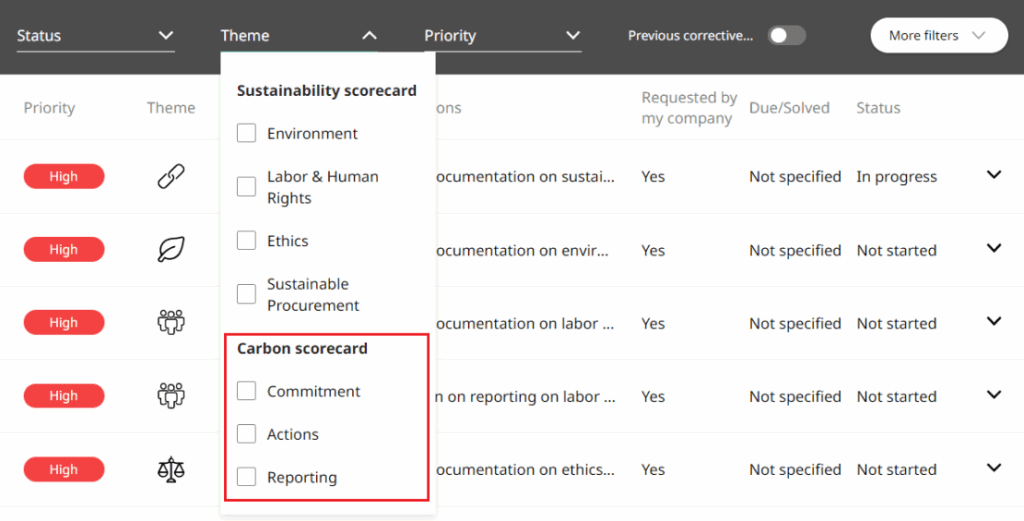 Improve supply chain transparency with EcoVadis
Improve supply chain transparency with EcoVadis
“EcoVadis is a daunting endeavour, but with the right tips and tools you can overcome its challenges”
Improving your EcoVadis score is not just about checking boxes and filling out a questionnaire, it’s about signalling to your stakeholders your commitment to sustainability, ethical practices, and responsible supply chain management. Whether you’re aiming to meet customer expectations, strengthen your brand reputation, or gain a competitive edge, a strong EcoVadis rating can open valuable opportunities. In this post, we’ll share five practical tips (three to do before you start your assessment and two while you’re filling out the questionnaire) to help you boost your EcoVadis certification & score and demonstrate real progress in your environmental, social, and governance (ESG) performance.
Nexio Projects expertise
As a global EcoVadis strategic partner since 2018, Nexio Projects supports organisations in achieving strong sustainability performance and unlocking value through ESG. With deep expertise across global EcoVadis standards and methodology, our team helps clients navigate assessments, improve scores, and integrate sustainability into core business strategy. We created a video series around EcoVadis assessment, from basics to tailored strategies for your organisation. Check out the series below!

Backed by 1,000+ projects across 20+ countries and 25+ sectors, we provide the clarity, structure, and support you need to turn ambitions into action. Here are 5 consolidated actions you can take that will directly affect the journey to improve your score.
Before you begin your assessment
Before you begin your new assessment, it is key to look back on how you did in the past and what you can do better. EcoVadis provides many tools to understand your previous assessment’s score. This is the first step to improving your score. The following three tips are steps you can take to improve your score by introducing new actions and addressing short comings from your previous assessment.
Tip number one: Identify quick wins
The first step to improving your score is to identify quick wins and address these. This can range from documents that have been rejected due to missing a logo, having the wrong page number specified or being outdated. Look in the document library for rejected documents and see why this may have happened. Most of the time it is a simple issue that will help you score points on the next assessment. For example, was a document rejected for being expired? Upload an updated version. Was a document rejected for not having a meaningful connection to your organisation? Upload a version with your company logo/branding.
Another way to get a quick win is to see if documents that have been uploaded for specific sub questions can be used elsewhere or expanded to cover more topics. For example, do you have a strong environmental policy covering GHG emissions and water but not biodiversity? Update the document with a new section while still utilising the old structure. Does your GHG and emissions awareness training also mention water saving actions? Make sure it is uploaded under both sections of the assessment.
Tip number two: Utilise your corrective action plan
Your corrective action plan is a useful tool that, when utilised effectively, can help your organisation make impactful changes. The plan can be accessed on the EcoVadis platform and outlines what EcoVadis defines as the most impactful missing aspects of your previous assessment. If your stakeholders (customers or suppliers) also use EcoVadis, they may also define what they find as the most important missing aspects for your organisation to work on.
If you are looking for more information around sustainability supply chain management or EcoVadis supplier ratings, read our newest factsheet!

EcoVadis rates each improvement area from your previous assessment with a level of priority and specifies how many of your stakeholders have specifically requested you address that improvement area. This can help you prioritise what actions to take. Additionally, the corrective action plan can help you track the changes you are making and communicate that to your stakeholders.
While all the actions outlined in the corrective action plan will help improve your organisations sustainability management system, only some of them contribute to your actual scorecard (which contributes to the medal you receive) while the rest contribute to your carbon scorecard. You can check this by comparing the actions to the questionnaire. All questions that start with CAR (found in the environmental and sustainable procurement pillars) relate only to your carbon scorecard (1).

Tip number three: Prioritise meaningful change
When working to improve your EcoVadis score to an EcoVadis Gold or Platinum, it is important to prioritise meaningful change that will support your organisation’s mission and improve your sustainability management system. EcoVadis is a very useful and influential framework to build out your organisation’s sustainability management system. However, the actions you take based on EcoVadis must also make sense for your organisation and drive real change for your stakeholders and the planet. Therefore, it is important to not use EcoVadis as a checklist of things that need to be done, but rather, as a framework to identify how your organisation can make meaningful improvements.
Actions that are taken that are also meaningful and beneficial for your organisation will be better implemented and thought out, leading to better acceptance rates of your documents and better scores. Actions that are taken solely to check a box and improve your score are less likely to be well implemented and risk being rejected. For example, one of the reasons documents get rejected by EcoVadis for specific subquestions is that the “document did not provide enough assurance that the actions were actually implemented, or the details in the evidence were insufficient for us [EcoVadis] to determine that”. Documents will also be rejected for being purpose made for the assessment.
Therefore, when making changes, it is important that such changes and relevant, beneficial and meaningful to your organisation. This will ensure they are implemented effectively and that you receive the proper credit for your action.
During your assessment
While you are working on your assessment there are also many steps that can be taken to ensure that you receive credit for all your hard work and increase your score. The following tips are steps that can be taken while you are filling out the assessment to maximise your organisation’s score.
Tip number four: Write explanatory comments
The comment attached to every document that is uploaded is a relatively underutilised feature that EcoVadis offers. The comment gives you a chance to explain the context behind a document, call out the important information and guide the analyst to the evidence included in the uploaded file.
As you deal with the policies and procedures of you organisation daily, the context of these documents may feel obvious to you, however, the EcoVadis analyst who examines your assessment may not have ever seen such a procedure or worked with a company in your industry before. Therefore, it is very important to include such context in comments. Additionally, uploaded documents can frequently be very large and include a lot of different information on a single page (e.g. in a sustainability report). Therefore, the comment can also be used to guide the analyst to where the information is on the page.
It is also important to ensure comments are concise and to the point. We recommend including the following information:
- A sentence on what the document is
- A sentence or two explaining how the document is used, the outcome and other relevant procedures or context
- A sentence on where this evidence is demonstrated in the page (if required)
If such a comment is included for every uploaded document, then you can help ensure that all your evidence is clear and understand, and, therefore, your organisation gets credit for all its actions.
Tip number five: understand the questions
While filling out the questionnaire, it is important that you have clearly understand every question and what it is asking of your organisation. We recommend downloading the questionnaire as an Excel file and working offline to have a better overview. The downloaded Excel view also clearly includes a description of every subquestion with example documentation (this overview can also be seen by clicking on the question mark in the online platform) (2).
Source: ecovadis.com
It is very important to read this overview as some questions are not explicit and could refer to a wide variety of topics. Additionally, your organisation may term procedures in a different way than EcoVadis (e.g. whistle-blower procedure, grievance mechanism, speak-up, and reporting hotline can all refer to the same thing).
An example of such confusion can be seen with the subquestion “actions to promote internal mobility”. At first glance, this could refer to actions taken by your organisation to help cover the costs of employees commute to and from work functions. However, upon further inspection of the explanation given by EcoVadis, we can see that this document should demonstrate actions taken by your organisation to promote employees internally before hiring externally.
Additionally, EcoVadis frequently changes its methodologies and questions, so while you may have understood a question last year, it is important to review the new guidance from EcoVadis on that question. For information on the broader changes made to the EcoVadis methodology in 2025, download our EcoVadis guide below.
Frequently asked questions
What are five simple actions to raise your EcoVadis score?
Identify quick-win documents, use your corrective action plan, prioritise meaningful changes, write clear explanatory comments on uploads, and engage suppliers and certifications to enhance evidence quality.
What kind of quick-win documents improve an EcoVadis score?
Quick wins include updated policies with correct branding/signatures, documents covering additional topics (e.g., biodiversity), and revised versions of previously rejected evidence that meet assessment criteria.
How can a corrective action plan (CAP) help improve EcoVadis performance?
The EcoVadis CAP identifies areas for improvement from your scorecard, helps prioritise high-impact themes and indicators, and supports structured change tracking which influences future scoring.
Why does supplier engagement matter for an EcoVadis assessment?
EcoVadis assigns weight to the ‘Sustainable Procurement’ pillar, so demonstrating meaningful supplier training, audits or ESG-integration directly supports higher scoring in supply-chain scrutiny.
When should organisations start acting on these five steps for their EcoVadis assessment?
Organisations should begin immediately upon reviewing their last assessment results—early action allows enough time to implement changes, evidence outcomes and prepare for submission before the next cycle.
The journey towards platinum
Improving your EcoVadis score is a long-term journey and does not happen overnight. However, by following these simple tips you can identify the gaps in your questionnaire and start to address them before the following assessment as well as fill out the assessment as effectively as possible. EcoVadis is about continuous improvement so ensure that you are making short-term and long-term plans on how to improve your score and implement actions. These plans should be reviewed on a regular basis. Your stakeholders, and the planet, will thank you.
Are you curious about the steps we take at Nexio Projects to evaluate our own past performance and improve our assessment? Check out latest blog post on our 2025 assessment here.
Need help navigating your EcoVadis journey? Get in touch for a free consultation or subscribe to our newsletter for monthly updates, tips, and insights.
References:
- EcoVadis (n.d.) How to use the Corrective Action Plan feature. [Online] Available at: https://support.ecovadis.com/hc/en-us/articles/360025780871-How-to-use-the-Corrective-Action-Plan-feature [Accessed 21 Jul. 2025].
- EcoVadis (n.d.) Understanding my questionnaire. [Online] Available at: https://support.ecovadis.com/hc/en-us/articles/14988568737170-Understanding-my-questionnaire [Accessed 21 Jul. 2025].











